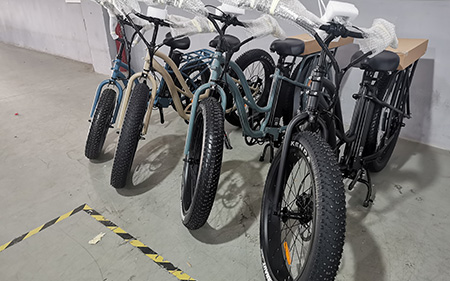What are the disadvantages of a fat tire bike?
 Jul 24, 2024|
Jul 24, 2024| View:207
View:207Fat tire bikes, also known as fat bikes, have gained popularity in recent years due to their ability to handle a variety of terrains, especially snow and sand. However, despite their unique advantages, these bikes also come with a set of disadvantages that potential buyers should consider before making a purchase. Here is a comprehensive look at some of the key disadvantages associated with fat tire bikes:
Weight and Portability
One of the most significant disadvantages of fat tire bikes is their weight. The large tires and robust frames needed to support them add considerable heft to the bike. This extra weight can make the bike cumbersome to carry, especially when you need to lift it up stairs or transport it in a vehicle.
Cost
Fat tire bikes are generally more expensive than traditional mountain bikes. The cost of the larger tires, specialized components, and the overall design contributes to a higher price tag. This can be a deterrent for budget-conscious cyclists or those new to the sport.
Rolling Resistance
The large volume and width of fat tires create more rolling resistance compared to standard bike tires. This means that more effort is required to move the bike forward, which can be tiring, especially on long rides or uphill climbs.

Speed and Efficiency
Due to the increased rolling resistance and weight, fat tire bikes are not as fast or efficient as their counterparts with narrower tires. Cyclists looking for speed and agility might find fat bikes to be a less than ideal choice.
Maneuverability
The wide tires and the bike's overall design can affect its maneuverability. Fat bikes can be more challenging to handle, especially at high speeds or on tight turns. This can be a concern for riders who value agility and responsiveness in their rides.
Limited Availability of Parts
Because fat tire bikes are a niche market, replacement parts and accessories may not be as readily available as those for more common bike types. This can make maintenance and customization more challenging and potentially more expensive.
Tire Selection
While the large tires are the defining feature of fat bikes, they also limit the variety of terrains the bike can excel in. On hard-packed trails or pavement, the tires may not perform as well as narrower, more specialized tires.
Storage and Space
The size of fat tire bikes can make storage an issue. They are bulkier and take up more space than regular bikes, which can be problematic for those with limited storage options.

Aesthetics
Some riders may not find the look of fat tire bikes appealing. The large tires and the bike's overall proportions can be a matter of personal taste, with some preferring the sleeker look of traditional bikes.
Learning Curve
For new riders or those transitioning from a different type of bike, there can be a learning curve associated with riding a fat bike. The different handling characteristics and the need to adjust to the bike's unique features can take time to get used to.
Climate and Weather Limitations
While fat bikes excel in snow and sand, they may not be the best choice for all weather conditions. In wet or muddy environments, the large tires can pick up more debris, and the bike's performance can be hindered.
Maintenance
The larger tires and components of a fat bike can require more maintenance than smaller bikes. Cleaning, lubricating, and inspecting the bike can be more time-consuming due to its size.
Gearing and Drivetrain
Fat bikes often have a different gearing setup to accommodate their slower speed and higher torque. This can make them less versatile for riders who want a bike that can handle a variety of riding conditions and speeds.
Market Saturation
As fat bikes have become more popular, the market has seen an influx of models and brands. This can make it difficult for consumers to choose the right bike, as not all fat bikes are created equal in terms of quality and performance.
In conclusion, while fat tire bikes offer unique benefits and are a lot of fun to ride, they are not without their drawbacks. Prospective buyers should weigh these disadvantages against the benefits to determine if a fat tire bike is the right fit for their riding preferences and needs.








View More(Total0)Comment lists